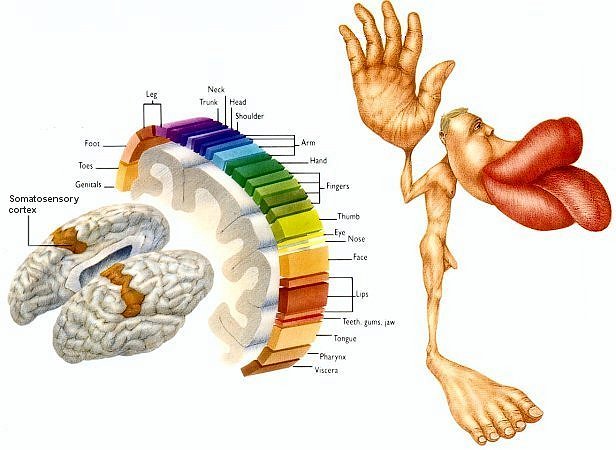RABBI INNI LIMA ANZALTA DUA
Search Cidpusa webcontinued from the Brain Page of Nervous System
Contents
Neurons and Nervesneurotransmitter
The Brain & Spinal Cord
Cranial Nerves
Peripheral Nervous System
Autonomic Nervous System
Senses: Eye diagrams, Hearing, Smell, Taste, Taste & Tongue Sensation, Balance
Memory , Memory types, Creation of Memory
Higher Functions
Altered States
-


receive the same attention of the brain.
The relative importance is often represented by mapping over the length of the sensory or motor cortex. These cortical maps (Figure 22b) are not drawn to scale; instead they are variously distorted to reflect the amount the neural processing power devoted to different regions. This accounts for the grotesque appearance of the human body in the homun-culus, which is a translation of the body's sensory map into the human form.Figure 22a Propriocep-tors[view large image]
Figure 22b Homunculus
[view large image]
-
Balance is an ongoing process that keeps our two-legged posture stable. Four main sets of sensory input are involved:
- Information from the skin is important, especially from the touch and pressure sensors on different parts of the feet, which tell the brain if you are leaning. This sense is not available in a free falling environment such as in a spacecraft.
- Eyesight is used to judge verticals and horizontals to which your body should be parallel and at right angle respectively.
- The body's proprioceptive sense of stretch in muscles, tendons, and joints tell the brain about the positions and angles of the arms, legs, torso, and neck.
- The sensory parts dedicated to balance is located deep inside each inner ear, next to the cochlea (seeFigure 09). These parts are known collectively as the vestibular apparatus and are part of the same network of fluid-filled chambers as the cochlea. They consist of the utricle, the saccule, and the semicircular canals (Figure 23a). In certain parts of their linings are tinny hairs, whose roots are embedded in lumpy crystals or gels. The crystals or gels are attracted downward by gravity, and they are also pushed to and fro by the fluid in the chambers, which swirls as the head changes its position.